DSNY Commissioner Kathryn Garcia Talks NYC’s Policies, Goals
Waste360 recently spoke with Garcia about how New York is progressing toward its zero waste goals and how a commercial franchise zoning system would work in a city like NYC.
Managing the waste and recycling needs of the largest city in the U.S. is no easy feat. City of New York Department of Sanitation (DSNY) Commissioner Kathryn Garcia accepted the challenge in March 2014 and has since helped develop and implement a wide range of initiatives to improve the city’s solid waste management system, including an e-cycle program and a residential curbside organics program.
Before joining DSNY, Garcia earned her bachelor’s degree in economics from the University of Wisconsin-Madison and gained experience in the environmental world by working at the New York City Department of Environmental Protection (DEP) for about seven years.
Now, Garcia is gearing up to take on one of the most challenging (and controversial tasks in the industry): developing and implementing a commercial franchise zoning system in New York.
“Currently, there are a lot of inefficiencies in how collection happens in NYC and having multiple trucks pick up materials on the same block at different times during the day is really putting a lot of pressure on NYC’s street infrastructure,” says Garcia. “With this plan, we want to move very slow and steady to get the ball rolling because this system would affect a large number of businesses, and we want to make sure that their waste is getting removed in the most effective and efficient way possible.”
Waste360 recently spoke with Garcia about how New York is progressing toward its zero waste goals, the challenges that come with managing a department that serves all five of its boroughs in all seasons and conditions and how a commercial franchise zoning system would work in a city like the Big Apple.
Waste360: How have your previous roles (working at the DEP and as a consultant at a nonprofit) impacted how you have managed the DSNY over the past few years?
Kathryn Garcia: When I was consulting, I was often looking at things from a very broad perspective and from a strategic and cost-benefit level for clients, which gave me the ability to step back and enter any situation without any biases.
Working at the DEP was in some ways very similar to DSNY and in some ways very different. Both use a lot of infrastructure and, ultimately, both organizations focus on figuring out how to move materials out of the city in an efficient and effective way. Additionally, both organizations focus on public health and ensuring that the City of New York is kept clean, whether that’s through waste management or wastewater management.
One of the things about DEP that is somewhat different than DSNY is that it has an incredibly long time horizon because it’s such a heavy infrastructure organization. Its planning horizon is always about 50 years. At DSNY, we are really good at collecting the garbage and recyclables in a way that almost no NYC residents have a perception about how much material we are actually moving in a given day and the scale of that enterprise. At DSNY, I am really focusing on articulating what DSNY will be in five years or 10 years, where the industry is going, what the staff should be prepared for in the future, etc.
I think the biggest change that I have brought to DSNY is refocusing our sustainability goals and making them a more prominent piece of what we are doing.
Waste360: NYC has set some of the most aggressive Zero Waste targets of any city in the U.S. How is NYC progressing toward those goals?
Kathryn Garcia: We are making slow and steady progress, and we are continuing to see the metrics around diversion increase. We are also continuing to develop new partnerships with the nonprofit sector around reuse, but the biggest piece of that puzzle is the expansion of the residential organics curbside collection program.
With that program, we are serving approximately 1 million people in the City of New York. And even though it’s still a voluntary program, we have plans to significantly expand the program this calendar year and next calendar year.
Currently, we are working on outreach for the program so that we can engage the public, and we are brainstorming new ways to do collection. Right now, a lot of our collection is done with dual-bin trucks (half refuse/half organic), and while that works for some neighborhoods, it doesn’t work for all neighborhoods. Our hope is to create a balance with organics collection trucks and refuse collection trucks, but it’s not necessarily a zero-sum game because the routes don’t work out that way. Moving forward, we will continue to run operations as efficiently as we can.
Waste360: What lessons have you learned in administering the residential organics curbside collection program and what can we expect to see from the program in the future?
Kathryn Garcia: We have learned a lot about the program since its implementation. One of the challenges is that the program is a mixed organics program, which means we collect both food waste and yard waste. That waste then needs to be hauled to either a compost facility or a digester and the specs for that can vary.
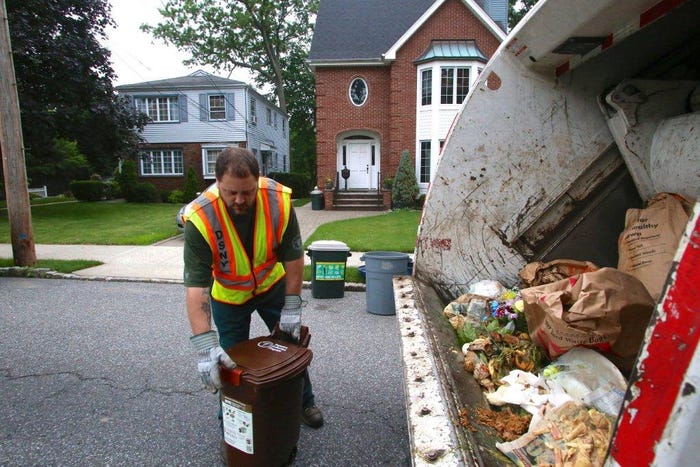
One of the things that we want to do as we expand to new neighborhoods this spring is more compost givebacks. It’s important for the residents to see what their food and yard waste can become and how their efforts are being put to good use.
We are also going to try and make sure that residents are able to use compostable bags in their bins because they don’t like their bins being grungy. In order to make that happen, we need to check with our facilities that process the organics waste to see if they can handle that type of contamination. In some of our newer contracts, we require that facilities mechanically separate contaminants from organics material.
Overall, it has been very exciting to move and drive this program forward, and I am excited to take the program even further.
Waste360: What are some of the challenges that come with managing a department that serves all five of NYC’s boroughs in all seasons and conditions?
Kathryn Garcia: Many areas of the city do not have the storage to only get refuse collection twice a week so we have slightly different collection schedules based on density. In our lower density areas, we provide collection services twice a week, and in the higher density areas, we provide collection services three times a week.
NYC is not a city that has alleys; it’s all about the curb. And the fact that majority of buildings have limited storage is a huge constrain for the City of New York broadly. Storage is also one of the reasons why the City of New York doesn’t and can’t utilize automated trucks. We don’t have the curb to work with because there is street parking, and no one is going to allow me to get rid of the parking.
Another challenge is placing employees on correct routes. If I put an employee who was born in Brooklyn on a route in Staten Island or Queens, I try to make sure that someone is keeping an eye on them because it can be easy to get lost. Manhattan has an easy grid layout to follow, but the other boroughs don’t have that, and I have to keep that in mind when assigning routes. To be honest, the geographical differences are harder for me to manage snow removal than regular collections.
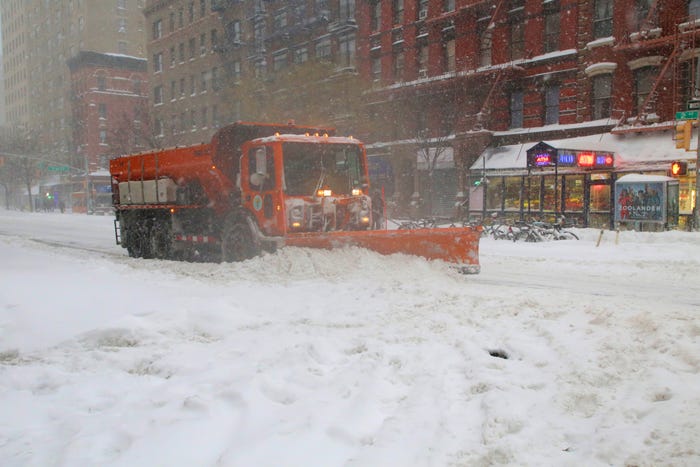
If we are in full snow operations, it’s almost guaranteed that I will cancel collections because meteorologists aren’t always 100 percent correct, and I don’t ever want to risk the safety of our staff or customers. When it comes to snow removal, there may be some parts of the city that get cleared out quicker than others, and when that happens, we will start doing first containerized collections and then move on to regular collections as quickly as possible.
Overall, we review what needs to be done every single day and then complete the tasks accordingly.
Waste360: DSNY aims to run a sustainable fleet. How is DSNY’s fleet maintained and how do you keep it up to date?
Kathryn Garcia: We work with all of the different departments in the waste and recycling industry to figure out what is out there and what is available. Companies will often give us prototypes so that we can test the trucks out and see if they will work in the City of New York. We also have a lab where we can test trucks’ emissions and features. Anytime we have a new vehicle, we take it and run it as hard as we can.
When testing, it’s especially important for us to find out if our employees are comfortable in the vehicles and if they can easily get in and out of the vehicles because they are working in all different types of weather and we don’t want them to have to worry about slippery footing or blind spots.
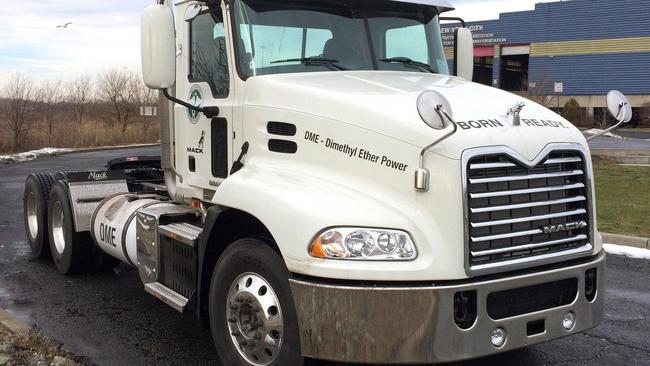
We recently formed a partnership with Mack, and the company is letting us drive around its new Dimethyl Ether-powered Mack Pinnacle model. The nice thing about this truck is that when you open up the hood, there is no after treatment anymore because it’s so clean. In addition to being sustainable, the truck could help make our preventative maintenance a lot easier.
Waste360: When it comes to collection and processing, what is the hardest thing about managing waste and recycling in a city like New York?
Kathryn Garcia: The hardest thing is being able to site facilities. In NYC, siting a garage or a transfer station is extremely difficult. When we determine that we need a new piece of infrastructure, it’s very challenging to figure out where we can put it and how we can get it constructed.
For collections, we need to make sure that the routes that we have designed match the weight of the trucks. We want the trucks to be as full as possible, but we don’t ever want them to go over their weight limits. We also try to avoid creating long routes because employees become miserable if they have to walk 25 miles a day. There are some routes that are quite long, but we try to avoid that.
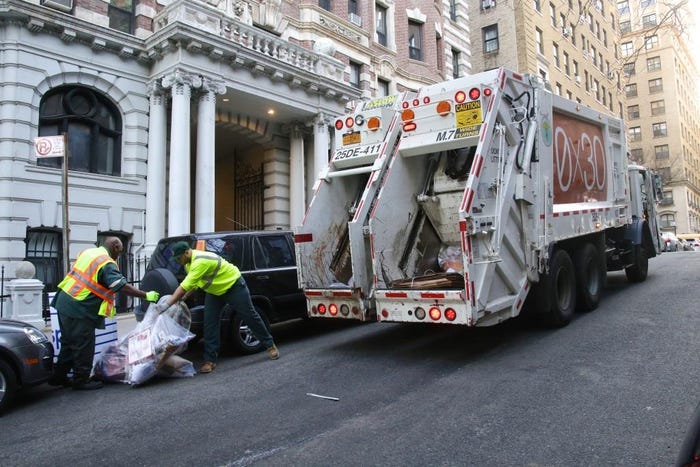
For processing, we either move the material out of the city or send it to one of our recycling vendors. Sims Municipal Reycling, which processes our metal, glass, plastic and cartons, has one of the most technically advanced processing units in the country. We do send waste significant distances at times so weather that’s happening in the Southeast can affect us. If we do have delays due to weather or other reasons, we will bring in additional containers to hold the materials until the weather system has passed or the problems have been resolved.
Waste360: Businesses in New York have been adjusting to the new recycling laws that went into effect on July 19, 2016. How is that going?
Kathryn Garcia: We have not started enforcing those new laws yet and will begin to do so in August. We also have not been tracking the recycling efforts widely, but we will start to get information from the city’s recycling facilities at the end of April to see whether or not their tonnages are up. Right now, businesses still have some time to adjust to the new laws before we start taking action.
Waste360: NYC’s “Vision Zero” action plan aims to cut down on traffic deaths and injuries. How has that affected sanitation operations given the safety challenges in the waste and recycling industry?
Kathryn Garcia: We have always been focused on making sure that we analyze the accidents that we have while working, and we have made some equipment adjustments to help reduce the risk of having an accident. Whether its adding side guards, increasing the amount of glass in the windshields for better visibility or seeing if we can put sensors on the trucks to improve blind spot warnings, we work hard to remain on the right path of structurally making our trucks safer.
On the people side, we run all of our employees through a defensive driving class and train them in the proper procedures and standards for backing. While we have well-trained drivers, we also have a lot of collisions. And about 50 percent of the time, our vehicles are not in motion when collisions take place. Other drivers try to squeeze by our trucks, and that’s obviously never a good idea.
We are also working in conjunction with our partners at the NYC Department of Transportation to ensure that all of our sanitation workers are aware of the proper safety procedures and the common dangers that could occur. We always remind our drivers that if they aren’t paying 110 percent attention at all times, bad things will happen.
Safety is part of our culture, and we always make sure that our folks are putting safety first so that we are operating safely at all times.
Waste360: L.A. is getting ready to roll out its commercial franchise zoning system in July, and last year, DSNY released a study recommending a commercial franchise zoning system. Are there any further developments on that idea and what needs to happen for a franchise zoning system to effectively work in New York?
Kathryn Garcia: We have said that we are going to pursue a franchise zoning system, and we anticipate our schedule to be somewhat similar to L.A.’s in terms of the amount of work that needs to be done in order to ensure that it’s done right. I would rather be slow and right than fast and wrong on this one. We have put out a request for proposal for some help with developing the implementation plan, and I anticipate getting responses back at the beginning of February.
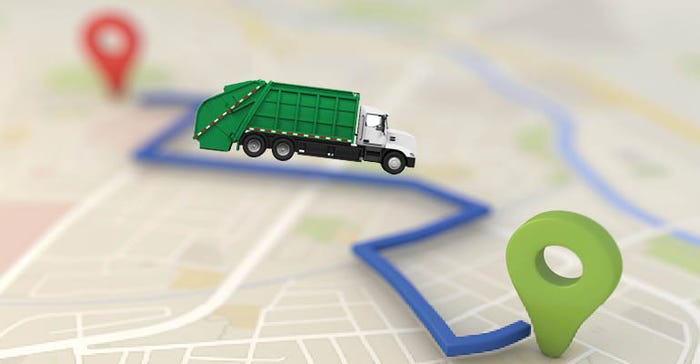
We have been doing a lot of outreach to the private carting industry in New York and businesses in large industry groups to make sure that we understand what their needs are. For example, a small restaurant is going to have a very different footprint and need than a large office building, and we are going to need some assistance in terms of what the size and scale of each of the geographic zones should be.
Ultimately, we want to make sure that the zones are balanced and desirable for both big and small players so that we can maintain the competitive component of the industry. We think that is important, and it’s going to take some time to do. But the benefits that appeared in a modeled franchise zoning system were pretty amazing, even if the models in the environment did not optimize everything.
Waste360: Are there other municipalities you look to in terms of gauging DSNY’s performance?
Kathryn Garcia: We look at other municipalities all the time but more so to learn about where new ideas are coming from, where new technologies are coming from and how those things are working in other areas. Every area is different, and not all ideas and technologies will work in every area.
Recently, some of my staff spoke with the City of Chicago about its experience with electric collection vehicles to see if that is something that is ready to come to NYC. If we cannot use something for residential or commercial collection purposes, we explore ideas for the parks department and other departments.
We also participate in different national organizations and conferences to learn everything we can from other municipalities’ experiences. We all have information to share, and we can all learn something from one another.
Waste360: Tell us about one of your mentors in the industry and how they have helped you become who you are today.
Kathryn Garcia: One of my biggest mentors is Emily Lloyd, the first woman sanitation commissioner at DSNY. She helped remind me that it’s important to make sure that you don’t view hard operational service jobs as just solely careers for men, even if it’s typically men who hold those jobs. There are a lot of opportunities in the waste and recycling industry and other industries for both men and women to have fun with logistics and to grow.
Waste360: What advice would you give to someone who wants a career in the waste and recycling industry?
Kathryn Garcia: There are a lot of opportunities in the waste and recycling industry. It’s a very data-driven industry, and there are a lot of jobs in planning and analysis, outreach and publication, transfer stations, landfills and processing facilities and more. The public is very important to our success so it’s important that we have people in this industry who can properly communicate with the public and educate customers on policies, procedures and goals.
Waste360: How do you manage waste and recycling in your own home?
Kathryn Garcia: I reside in a neighborhood that is part of the residential organics collection program, but I made the decision to divert organics in my own home prior to joining DSNY. In my home, I have a small counter organics bin, a garbage bin, two paper recycling bins (one next to where we keep the mail) and a metal, glass and plastic recycling bin.
I am proud to say that I think I have finally gotten my children and their friends to dispose of everything properly. Occasionally, I will find materials in the wrong bin, but for the most part they understand where everything goes.
Waste360: Where do you like to spend your downtime?
Kathryn Garcia: It depends on the season. My family and I really enjoy going to the Brooklyn Botanic Garden, the Whitney Museum of American Art and the Brooklyn Museum. We also live within a few blocks of some really nice restaurants that we go to frequently, but I have been working on teaching my children how to cook recently so we can enjoy more meals at home.
About the Author
You May Also Like




